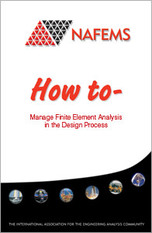With all major manufacturers embracing predictive simulation, small to medium sized companies must acknowledge that the value of this important technology is real. The statement (or excuse) "It doesn't work for us", carries less traction as more & more companies document success with the technology. What is apparent is that some companies are more successful with simulation technology than others, often within the same industry.
In this executive level session, Vince Adams, author of three books and an internationally invited speaker on design analysis will share the secrets of why some companies are designing better products with predictive technologies. This webinar will outline the best practices to help your company improve product cost, performance, design cycle time, and the ability to innovate.
Related  NAFEMS Publication:
NAFEMS Publication:
How to Manage Finite Element Analysis in the Design Processby Vince Adams
It is now widely understood that product simulation, and Finite Element Analysis (FEA) in particular, is a tool for use during the design process, rather than a tool for use in checking the suitability of a near-final design. There is, however, a growing concern that users with sub-par skills and/or engineering know-how now are armed with a tool that could either lengthen the design process by facilitating erroneous design decisions or, what is worse, lead a manufacturer to commit to products that are less optimized or less safe than anticipated. Software vendors are doing their jobs by adding more functionality in increasingly user-friendly interfaces with better, albeit varied, Computer-Aided Design (CAD) integration.
In the face of this dramatic rise in functionality, managers at many companies are finding themselves with the opportunity to use simulation for advanced analysis, but with less and less grasp of its capabilities and limitations. The engineering content—the purpose of the simulation task in the first place—is often overshadowed by the glut of information pouring out of these faster, “more intuitive” systems. The NAFEMS book Management of FEA: Guidelines to Best Practice reminds us that impressive FE models buy a user very little if the meaning of the data is unclear or the task does not lead to improved design. (cont ...)
Agenda
Welcome & Introduction
Matthew Ladzinski, NAFEMS North America
Management of Design Analysis
Vince Adams, SolidWorks
Q & A Session
Closing

 NAFEMS Publication:
NAFEMS Publication:  Over the past 25 years, Vince Adams has enjoyed multiple successes as a Product Design Engineer and Project Manager, accumulation several US & international patents. He learned the power of finite element analysis (FEA) as a design tool early in his career and has helped shorten the learning curve for many designers by sharing his experiences.
Over the past 25 years, Vince Adams has enjoyed multiple successes as a Product Design Engineer and Project Manager, accumulation several US & international patents. He learned the power of finite element analysis (FEA) as a design tool early in his career and has helped shorten the learning curve for many designers by sharing his experiences. 
